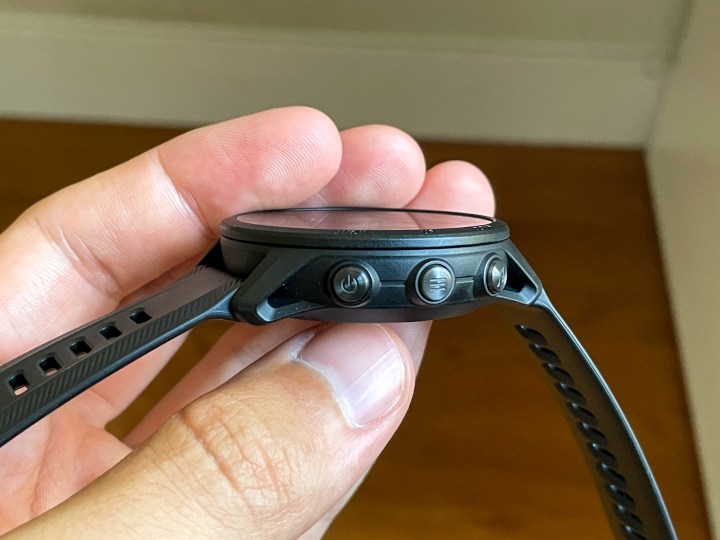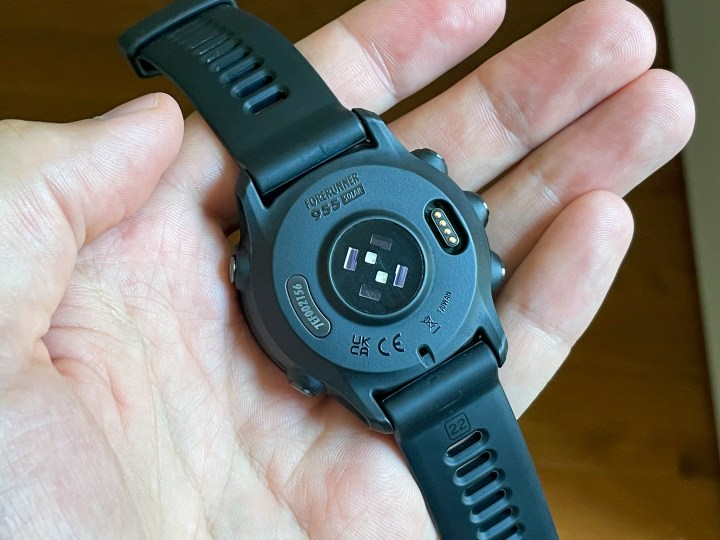
“This is a serious watch for serious runners. If that's you, you'll be ecstatic with everything the 955 Solar has to offer.”
- Incredible battery life
- Consistently accurate GPS tracking
- Touch screen and 5-button navigation
- Easy-to-read screen in all conditions
- Great fitness and health features
- Solar version is overkill for most runners
- Core features identical to lower Forerunners
Standing in the starting corrals of any running race, you’ll see a wide variety of gear. Dozens of brands of shoes, shorts, sunglasses, and hats. Over thousands of miles running, each person finds the unique setup that works best for them. But when you focus on people’s wrists, one name dominates: Garmin. It isn’t a fashion statement or fad; Garmin has a well-earned reputation as the best smartwatch for runners, providing the features, design, and reliable performance we require. It’s constantly reinforced for me: The more serious the race, the more Garmins you see.
For the past two years, I’ve been running exclusively with a Forerunner 245 Music — an affordable, but not completely budget, Garmin model available for about $275. Now I’m fortunate to be using Garmin’s latest, highest-end Forerunner: the 955 Solar. At $600, it’s immediately clear this isn’t for the casual runner tracking morning jogs. And frankly, given all of its capabilities, it’s overkill for most people, unless you plan on getting into triathlons or ultramarathons. It’s also notably more expensive than all but the stainless steel-cased Apple Watch Series 7.
Here’s everything it has to offer, and my recommendations for runners who are eyeing Garmin’s latest and greatest.
Testing over weeks and miles

I’ve now logged 200 miles running with the Forerunner 955 Solar on my wrist, in addition to plenty of walks, bike rides, and rounds of golf, all across over seven weeks. When I’m not running, I’ve been wearing it as a daily smartwatch paired to my iPhone.
I’m on track to run over 1,000 miles in 2022. I have already run three half marathons this year, and this watch arrived at a perfect time to get me moving on my fall marathon training cycle. (Huge thanks to Nike for inviting me to join its NYC group training for Chicago!). I’m used to wearing my previous Forerunner, and picky about what a running watch offers. I also have a lovely assistant on this review, my girlfriend, who has been running with this watch’s predecessor, the Forerunner 945 — so I tapped her expertise for finer points of comparison between the two closely related models.
The Garmin Forerunner basics
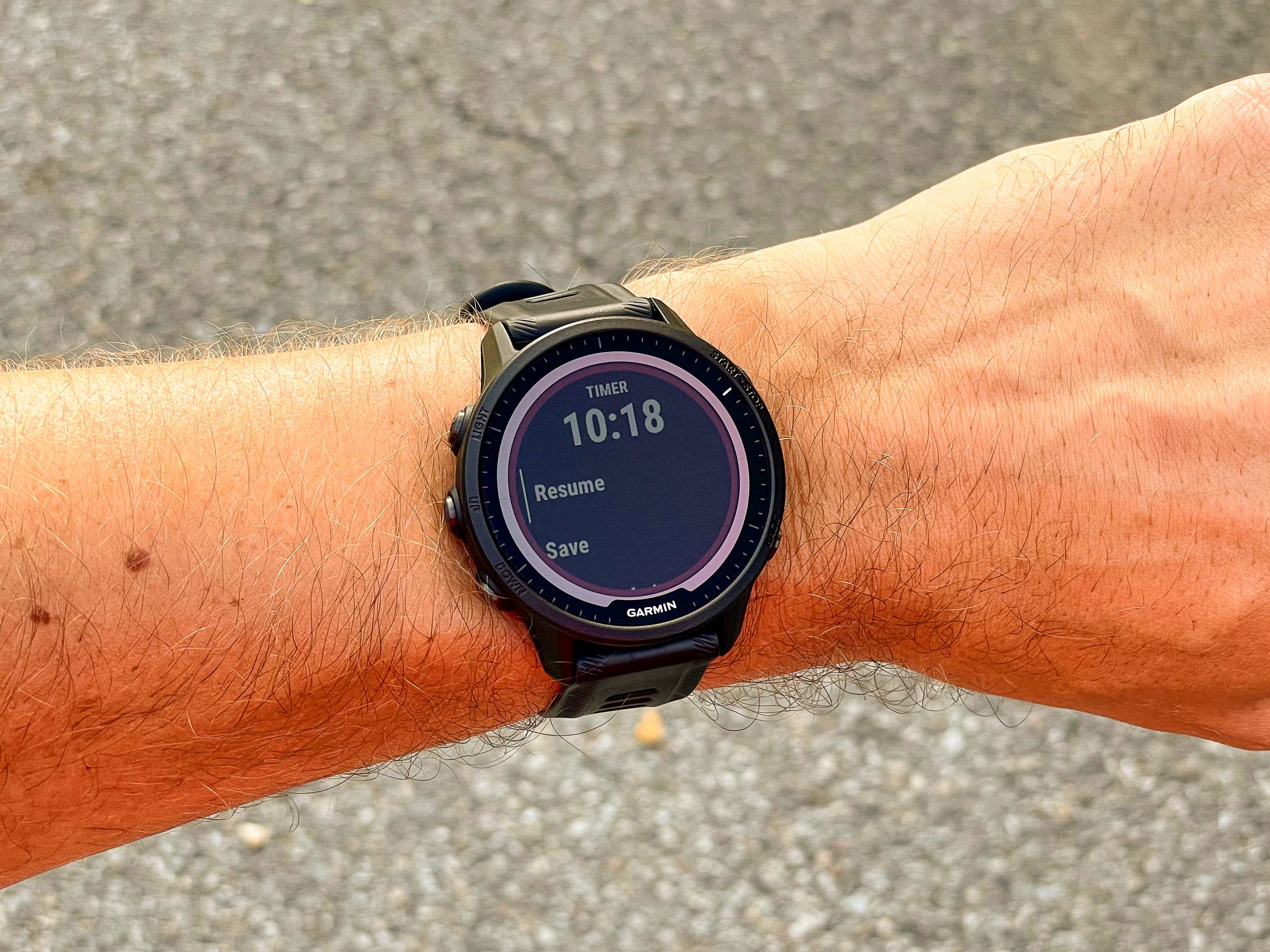
Let’s quickly get through the basics, because I really don’t need to get into every little detail. You likely won’t get the Forerunner 955 as your first running watch, or your first Garmin. Chances are you have a Garmin already and you know what you’re getting into here.
This is Garmin’s top-end Forerunner model, which — as the name suggests — targets avid runners. At $600, it’s topped only by some of Garmin’s Fenix and Enduro multisport watches, and specialist models for divers and pilots. This is, in many respects, top of the line.
For that money, you’re getting a large watch with just about everything Garmin has to offer. A big 1.3-inch always-on color touchscreen, every GPS tracking mode and sensor you could ever want (and more you didn’t know existed), waterproofing, a rugged exterior, a massive 32GB of storage, a huge battery, and solar charging capabilities.
If you take running seriously, you wear a Garmin.
Garmin’s smartwatches pair to an iPhone or Android with the Garmin Connect app, bringing you a whole suite of fitness and wellness functions for no additional subscription. You can track absolutely everything about your training, performance, body condition, recovery, and general health stats with this watch. And Garmin does its best to turn that data into actionable insights for you — whether you’re casually scrolling through the main feed, or diving deep into the analytics.
That focus on activity tracking doesn’t leave much room for anything else. There are other apps you can install and run on the Forerunner series, but they’re very utilitarian in nature. It’s likely that everything you’d like to do with a Garmin is pre-loaded on the watch, and integrated very well at that. A series of home screen panels covers everything you need to know about your health and fitness, and you get small things on top like alarms, timers, the weather, and notifications from your phone.
Display
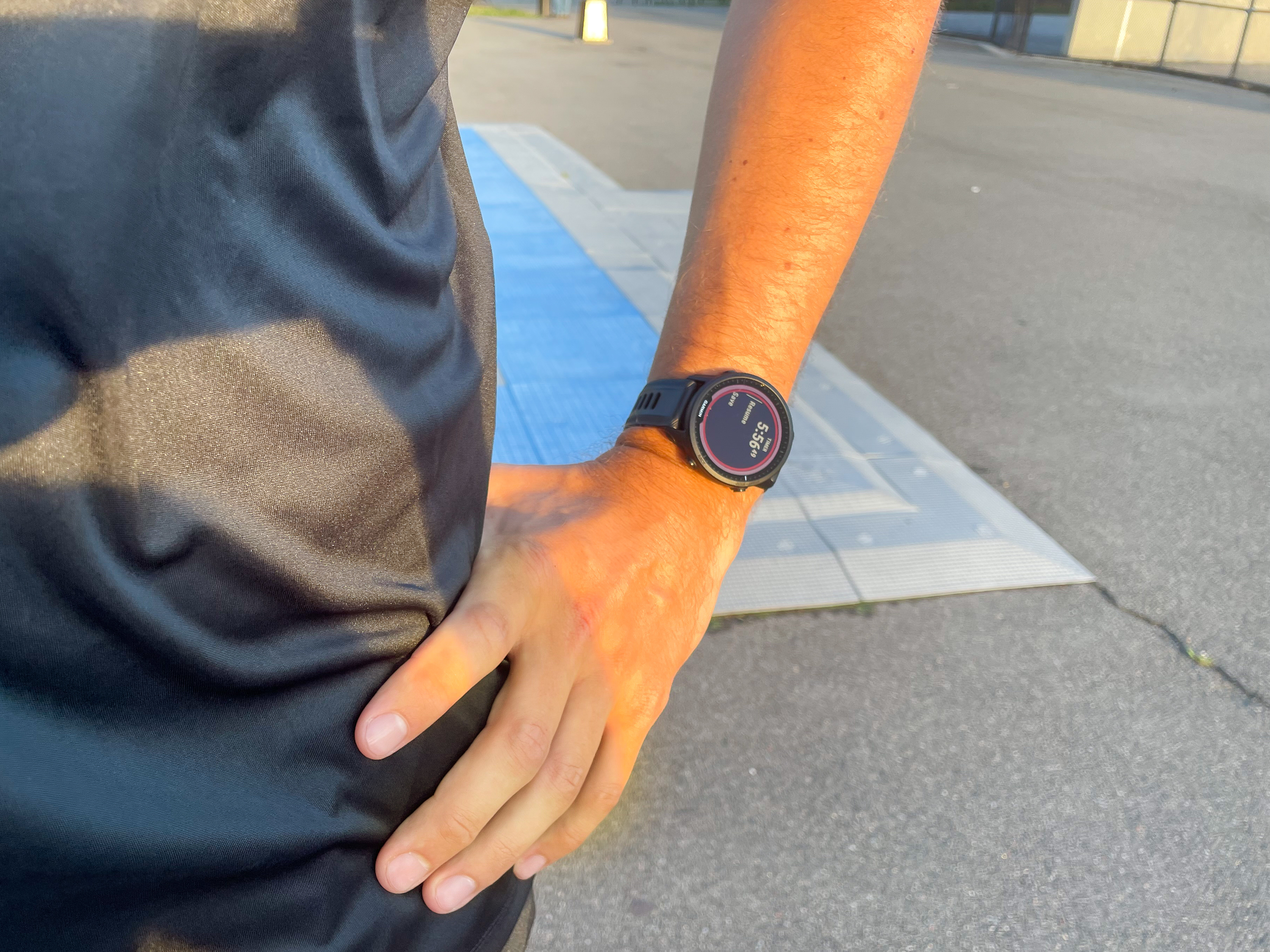
The 1.3-inch display is slightly larger than the Forerunner 945’s 1.2-inch, despite the case actually being slightly narrower. The resolution has bumped up as well, to 260 x 260 pixels, though that simply leaves you with the same pixels per inch as the old model. The screen is improved, though. Side by side with the 945, you can see the blacks are much deeper, and the backlighting is noticeably better.
I fully expected the display to be much better than my Forerunner 245, but I didn’t expect that the difference would be this dramatic. The larger screen, paired with the higher resolution and improved clarity, just makes the 955 Solar a joy to use. It’s easy to see everything on the display at a glance while running, even in direct sunlight and at an angle. That’s a differentiator for all Garmin watches when compared to an Apple Watch or Galaxy Watch, but it’s in top form on the 955.
You don’t want glare — or a touchscreen — to think about while running.
The display’s quality is particularly noticeable when viewing more intricate and colorful content on the main home screens, as well as when navigating a mapped route during a run. Sure, it’s not delivering OLED display levels of clarity … but those displays also bring huge compromises in battery life and glare.
You get Gorilla Glass DX glass over the screen, not a synthetic sapphire. Perhaps that’s disappointing at this price, but I wouldn’t count out Garmin making the decision based on the shatter resistance of the materials. I make zero effort to protect this watch, so unsurprisingly, I have a couple of faint scratches on the glass. They’re only viewable at certain angles, and I can’t feel them with a fingernail, so it’s hard to complain.
Touchscreen and buttons
This generation also added touch capability to the screen — something available on other Garmins, but not the Forerunner 945. Critically that doesn’t come at the expense of physical buttons. You can still navigate the entire interface with the traditional Garmin 5-button layout, and the touch screen is disabled by default when tracking activities. If you aren’t a runner, this may not make sense to you — but trust me, you do not want a touchscreen when running. Accidentally having rain, drips of sweat, or a brush with your shirt pause or lap your run without you knowing really stinks.
The Garmin interface is so simple and easy to manage with the 5-button system that I often went days forgetting that it even had a touchscreen. It’s only useful when you’re scrolling through notifications or lists of settings, and when you do use it it’s smooth and responsive. So sure, it’s nice to have, but Garmin could’ve removed this feature and likely not lost any customers. I suspect it’s mostly there to help placate folks who are on the fence coming over from touchscreen watches and see the 5-button layout as antiquated. (They’ll be converted to the buttons in short order, though.)
Design, size, and comfort
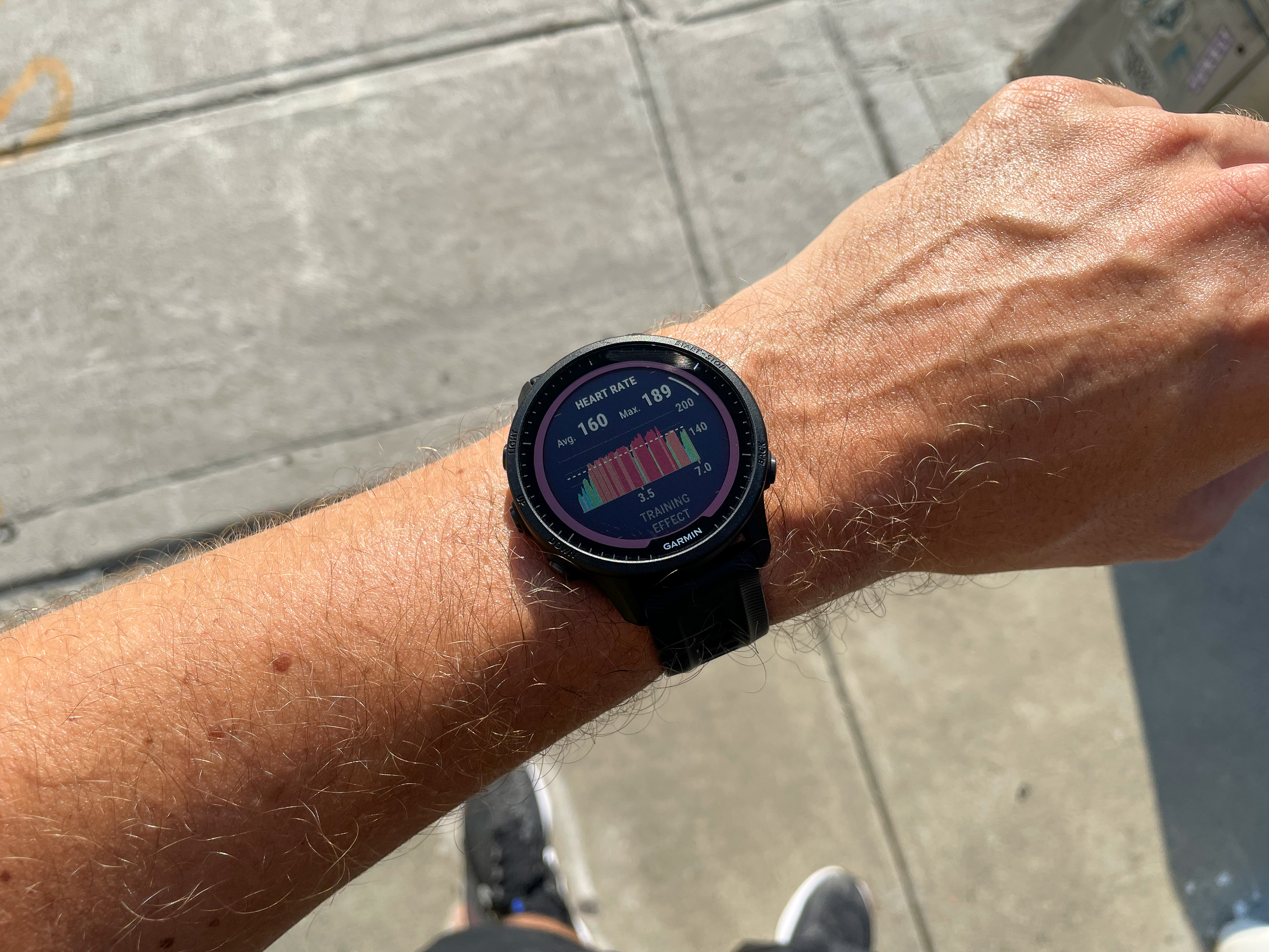
Garmin Forerunners certainly have a unique design. They aren’t trying to be particularly svelte or sleek; they’re utilitarian and purposeful. The 955 Solar’s chunky plastic body has a few smooth curves and fashionable cuts on the side, but otherwise simply takes up as much space as it needs to in order to fit the myriad components inside.

There is one nice design flourish on the front, the reflective solar ring around the screen, which gives an interesting sheen and colorful pop depending on the lighting. It’s also a bit of an “if you know, you know” nod to other Garmin wearers you see out on the street, showing off that you have a high-end version.
For its size, the Forerunner 955 Solar is light and comfortable on my wrist — for daily wear, long runs, and even sleeping. But on my girlfriend’s smaller wrist, it looks a bit comical. You’ll really want to try this one on before buying if you’re petite, and maybe consider a 700-series model instead.
The band is particularly light and breathable, as is the case with every Garmin I’ve worn, but the trade-off is that the whole package can feel a bit cheap. I know it’s sturdy, and weight reduction is paramount, but if you’re comparing this to more fashion-focused metal smartwatches, you’ll be disappointed.
Battery life
One of the key reasons Garmin purists are so reluctant to switch off of the platform for something fancy like an Apple Watch is the battery longevity, and the 955 delivers here. Garmin claims a remarkable 20 days of battery life in simple smartwatch mode connected to your phone, plus a very impressive 42 to 49 hours of usage in GPS mode.
That’s 5 more days in smartwatch mode and 7 more hours in GPS tracking mode than even the non-Solar 955.

That solar-boosted battery life, according to Garmin, is based on the watch spending a considerable amount of time out in considerable amounts of sunlight. The “20 days” measurement requires 3 hours per day outdoors in 50,000 lux sunlight, and the additional 7 hours of use in GPS mode requires continuous exposure to that same 50,000 lux. If you don’t know lux measurements by memory (I sure don’t), 50,000 lux is equivalent to a moderately sunny day at high noon or a clear day in the morning or afternoon. Garmin users probably spend more hours per week outside than the average adult, though, so I wouldn’t be surprised if the most active among us would get value out of the Solar model.
My old Forerunner 245 quotes just 7 days of smartwatch usage or 6 straight hours of GPS tracking. It is, after all, a much less expensive watch with a much smaller case and battery. Switching over, I’ve been floored by the battery life on the 955 Solar. The added longevity is perhaps the most noteworthy advantage of this model over lesser Forerunner offerings.
You can easily use this for two weeks without charging, even with many runs.
With the 955 Solar, you can easily make it a full two weeks without charging, even if you’re going on multiple multi-hour runs per week. And that’s enticing. Not worrying about charging even when I’m heading out for a long run with just 10% battery left is refreshing. My experience testing for the better part of two months has met or beat Garmin’s estimates above; I typically saw around 2% battery usage per hour of multi-band GPS tracking.
It is worth noting that the standard Forerunner 955 without solar will likely still be way above most people’s expectations, and serve all but the most extreme ultramarathoner’s needs for tracking. I’m also keenly aware of how quickly Garmins recharge; it’s even less of a pain when you’re only topping it off once every several days. If I were buying for myself, I’d skip the $100 solar up-charge.
GPS tracking accuracy
This is why we’re all wearing Garmins for running: GPS tracking accuracy. Running a majority of my miles in densely packed New York City, I’ve seen some seriously wonky stuff happen with wrist-bound GPS tracking, mostly with my Apple Watch but even at times with my Forerunner 245. The 955 has consistently outperformed my 245 in the time it takes to lock GPS before starting an activity, and the consistency with which it’s able to track pace even when running along city streets and between tall buildings.
Compared to my Forerunner 245, and even the Forerunner 945, the 955 comes with additional GPS tracking modes. You can choose to use the “All + Multi-Band” mode to leverage all possible GPS constellations together. Even leaving my watch in the default “smart” tracking mode rather than the more battery-intense “every second” plotting, my 955 stayed dead on next to the 945 using its most accurate and battery-intensive tracking settings.
I only had a single instance where the GPS struggled to lock on, and it was unsurprisingly the one time I decided to be impatient and start a run before the watch indicated it had a complete lock. When I waited for a GPS lock (every other run, of course), I was tracking perfectly every time.
Our take
The Garmin Forerunner 955 Solar is an outstanding runner’s watch that exceeded my expectations. Unless you run — and run a lot — you won’t understand why you’d spend $600 on such a utilitarian smartwatch with few of the modern smartwatch bells and whistles. But anyone who’s making it to the bottom of this review will get it, and at that point, you’ll likely be seriously considering buying one for yourself.
My only recommendation against the Garmin Forerunner 955 Solar is that whole solar part. The existence of the non-solar model for a full $100 less, with still-great battery life and all of the same features, makes it tough to recommend that higher-end model for anyone but the most dedicated long-distance runners. The battery life will still be excellent, and Garmins charge very quickly.
If you have a lower-end (or older) Forerunner and you’re looking to upgrade as you take running more seriously, you’ll love the 955 Solar’s bigger screen, absurdly great battery life, and precise tracking paired with the software and interface you already know. If you’re just coming to the Forerunner lineup from something like an Apple Watch, Galaxy Watch, or Wear OS watch, chances are this is overkill — start out with something simpler, like the Forerunner 245, and see if this is a trade-off you’re willing to make.
I won’t be going back to my Forerunner 245, that’s for sure. The screen, battery life, and GPS accuracy on the 955 Solar have opened my eyes to the value of getting the top-end Garmin model.

